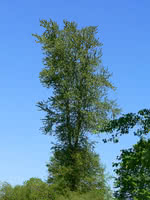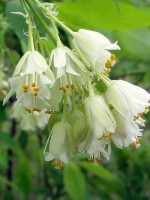Mon-Fri 9am - 5pm Mountain time
Black Cottonwood vs American Bladdernut
Populus trichocarpa
Staphylea trifolia
NOT AVAILABLE THIS SEASON - MIGHT RETURN
Black Cottonwood is the largest and tallest of the North American poplars. Named after its white, fluffy seeds with cottony hairs, this hardy tree produces sticky, fragrant buds and has a straight growth habit. Black Cottonwood needs ample moisture and nutrients to grow successfully to full height and are found in the Western provinces and the Yukon with BC being its heartland.
American Bladdernut is a fast-growing, ornamental shrub native to eastern North America. It can be grown as a large shrub or trained as a small tree. The small, drooping, white flowers are bell-shaped and grow in clusters. They appear in mid to late spring, attracting various pollinators. Well suited as an understory plant as it prefers shady and partial sun location with moist soils.
The blossoms mature into papery seed capsules and have been described as miniature Japanese lanterns. They are commonly used in dried flower arrangements. The seeds found within the pods are edible, and have a taste similar to pistachios. They can be eaten raw, used in baking or made into a sweet cooking oil.
Care should be taken when planting American Bladdernut, as it can spread quickly. It is prone to suckering and will self-seed. Plant the right tree in the right place.

